Numerical Solutions of the (2+1)-Dimensional Nonlinear and Linear Time-Dependent Schrödinger Equations Using Three Efficient Approximate Schemes
Abstract
1. Introduction
2. Mathematical Preliminaries
2.1. (2+1)-Dimensional Nonlinear Schrödinger Equation (2D NLSE)
2.1.1. Method 1: Split-Step Fourier Transform Method
2.1.2. Method 2: Fourier Pseudo-Spectral Method
2.1.3. Method 3: Hopscotch Method
2.2. (2+1)-Dimensional Time-Dependent Linear Schrödinger Equation (2D TDSE)
2.2.1. Method 1: Split-Step Fourier Transform Approach
2.2.2. Method 2: Fourier Pseudo-Spectral Method
2.2.3. Method 3: Hopscotch Method
3. Numerical Experiments
3.1. Simulations of the 2D NLSE
3.1.1. Error and Convergence Analysis
3.1.2. Results and Discussion
3.2. Simulations of the 2D TDSE
3.2.1. Error and Convergence Analysis
3.2.2. Results and Discussion
4. Conclusions
Author Contributions
Funding
Institutional Review Board Statement
Informed Consent Statement
Data Availability Statement
Conflicts of Interest
References
- Jiwari, R.; Kumar, S.; Mittal, R.C.; Awrejcewicz, J. A meshfree approach for analysis and computational modeling of non-linear Schrödinger equation. Comput. Appl. Math. 2020, 39, 95. [Google Scholar] [CrossRef]
- Taha, T.R.; Ablowitz, M.I. Analytical and numerical aspects of certain nonlinear evolution equations. II. Numerical, nonlinear Schrödinger equation. J. Comput. Phys. 1984, 55, 203–230. [Google Scholar] [CrossRef]
- Akhmediev, N.N.; Korneev, V.I. Modulation Instability and Periodic Solutions of the Nonlinear Schrödinger Equation. Theor. Math. Phys. 1987, 69, 1089–1093. [Google Scholar] [CrossRef]
- Kibler, B.; Fatome, J.; Finot, C.; Millot, G.; Genty, G.; Wetzel, B.; Akhmediev, N.; Dias, F.; Dudley, J.M. Observation of Kuznetsov-Ma soliton dynamics in optical fibre. Sci. Rep. 2012, 2, 463. [Google Scholar] [CrossRef]
- Peregrine, D.H. Water waves, nonlinear Schrödinger equations and their solutions. ANZIAM J. 1983, 25, 16–43. [Google Scholar] [CrossRef]
- Kibler, B.; Fatome, J.; Finot, C.; Millot, G.; Dias, F.; Genty, G.; Akhmediev, N.; Dudley, J.M. The Peregrine soliton in nonlinear fibre optics. Nat. Phys. 2010, 6, 790–795. [Google Scholar] [CrossRef]
- Belić, M.R.; Nikolić, S.N.; Ashour, O.A.; Aleksić, N.B. On different aspects of the optical rogue waves nature. Nonlinear Dyn. 2022, 108, 1655–1670. [Google Scholar] [CrossRef]
- Akhmediev, N.; Kibler, B.; Baronio, F.; Belić, M.; Zhong, W.P.; Zhang, Y.; Chang, W.; Soto-Crespo, J.M.; Vouzas, P.; Grelu, P.; et al. Roadmap on optical rogue waves and extreme events. J. Opt. 2016, 18, 063001. [Google Scholar] [CrossRef]
- Nikolić, S.N.; Radonjić, M.; Lučić, N.M.; Krmpot, A.J.; Jelenković, B.M. Transient development of Zeeman electromagnetically induced transparency during propagation of Raman-Ramsey pulses through Rb buffer gas cell. J. Phys. B At. Mol. Opt. Phys. 2015, 48, 045501. [Google Scholar] [CrossRef]
- Li, Z.Y.; Li, F.F.; Li, H.J. Exciting rogue waves, breathers, and solitons in coherent atomic media. Commun. Theor. Phys. 2020, 72, 075003. [Google Scholar] [CrossRef]
- Hu, H.; Chen, Y. Numerical solution of two-dimensional nonlinear Schrödinger equation using a new two-grid finite element method. J. Comput. Appl. Math. 2020, 364, 112333. [Google Scholar] [CrossRef]
- Sun, Z. A conservative scheme for two-dimensional Schrödinger equation based on multiquadric trigonometric quasi-interpolation approach. Appl. Math. Comput. 2022, 423, 126996. [Google Scholar] [CrossRef]
- Antoine, X.; Besse, C.; Klein, P.; Antoine, X.; Besse, C.; Klein, P.; Solution, N. Nonlinear, Numerical Solution of Time-Dependent Nonlinear Schrödinger Equations Using Domain Truncation Techniques Coupled with Relaxation Scheme. Laser Phys. 2011, 21, 1491–1502. [Google Scholar] [CrossRef]
- Wang, Y.; Hao, Z.; Du, R. A Linear Finite Difference Scheme for the Two-Dimensional Nonlinear Schrödinger Equation with Fractional Laplacian. J. Sci. Comput. 2022, 90, 24. [Google Scholar] [CrossRef]
- Geng, J.; Xue, S. Reducible KAM tori for two-dimensional nonlinear Schrödinger equations with explicit dependence on the spatial variable. J. Funct. Anal. 2022, 282, 109430. [Google Scholar] [CrossRef]
- Seadawy, A.R. Exact solutions of a two-dimensional nonlinear Schrödinger equation. Appl. Math. Lett. 2012, 25, 687–691. [Google Scholar] [CrossRef]
- Bulut, H.; Pandir, Y.; Tuluce, S. Demiray, Exact solutions of nonlinear Schrödingers equation with dual power-law nonlinearity by extended trial equation method. Waves Random Complex Media 2014, 24, 439–451. [Google Scholar] [CrossRef]
- Durur, H.; Ilhan, E.; Bulut, H. Novel complex wave solutions of the (2+1)-dimensional hyperbolic nonlinear schrödinger equation. Fractal Fract. 2020, 4, 41. [Google Scholar] [CrossRef]
- Wang, L.; Luan, Z.; Zhou, Q.; Biswas, A.; Alzahrani, A.; Liu, W. Bright soliton solutions of the (2+1)-dimensional generalized coupled nonlinear Schrödinger equation with the four-wave mixing term. Nonlinear Dyn. 2021, 104, 2613–2620. [Google Scholar] [CrossRef]
- Burdik, C.; Shaikhova, G.; Rakhimzhanov, B. Soliton solutions and traveling wave solutions of the two-dimensional generalized nonlinear Schrödinger equations. Eur. Phys. J. Plus. 2021, 136, 1095. [Google Scholar] [CrossRef]
- Moxley, F.I.; Chuss, D.T.; Dai, W. A generalized finite-difference time-domain scheme for solving nonlinear Schrödinger equations. Comput. Phys. Commun. 2013, 184, 1834–1841. [Google Scholar] [CrossRef]
- Kalita, J.C.; Chhabra, P.; Kumar, S. A semi-discrete higher order compact scheme for the unsteady two-dimensional Schrödinger equation. J. Comput. Appl. Math. 2006, 197, 141–149. [Google Scholar] [CrossRef]
- Dehghan, M.; Shokri, A. A numerical method for two-dimensional Schrödinger equation using collocation and radial basis functions. Comput. Math. Appl. 2007, 54, 136–146. [Google Scholar] [CrossRef]
- Jin, J.; Wu, X. Convergence of a finite element scheme for the two-dimensional time-dependent Schrödinger equation in a long strip. J. Comput. Appl. Math. 2010, 234, 777–793. [Google Scholar] [CrossRef]
- Tian, Z.; Chen, Y.; Huang, Y.; Wang, J. Two-grid method for the two-dimensional time-dependent Schrödinger equation by the finite element method. Comput. Math. Appl. 2019, 77, 3043–3053. [Google Scholar] [CrossRef]
- Gotoh, H.; Koshiba, M.; Tsuji, Y. Finite-element time-domain beam propagation method with perfectly matched layer for electron waveguide simulations. IEICE Electron. Express 2011, 8, 1361–1366. [Google Scholar] [CrossRef]
- Atia, K.S.R.; Heikal, A.M.; Obayya, S.S.A. Smoothed finite element method for time dependent analysis of quantum resonance devices. Opt. Quantum Electron. 2018, 50, 127. [Google Scholar] [CrossRef]
- Khordad, R.; Firoozi, A.; Sedehi, H.R.R. Simultaneous Effects of Temperature and Pressure on the Entropy and the Specific Heat of a Three-Dimensional Quantum Wire: Tsallis Formalism. J. Low Temp. Phys. 2021, 202, 185–195. [Google Scholar] [CrossRef]
- Jiang, T.; Chen, Z.C.; Lu, W.G.; Yuan, J.Y.; Wang, D.S. Efficient split-step and implicit pure mesh-free method for the 2D/3D nonlinear Gross–Pitaevskii equations. Comput. Phys. Commun. 2018, 231, 19–30. [Google Scholar] [CrossRef]
- Farag, N.G.; Eltanboly, A.H.; El-Azab, M.S.; Obayya, S.S.A. Pseudo-spectral approach for extracting optical solitons of the complex Ginzburg Landau equation with six nonlinearity forms. Optik 2022, 254, 168662. [Google Scholar] [CrossRef]
- Zheng, R.; Liu, F.; Jiang, X.; Turner, I.W. Finite difference/spectral methods for the two-dimensional distributed-order time-fractional cable equation. Comput. Math. Appl. 2020, 80, 1523–1537. [Google Scholar] [CrossRef]
- Han, C.; Wang, Y.L. Numerical Solutions of Variable-Coefficient Fractional-in-Space KdV Equation with the Caputo Fractional Derivative. Fractal Fract. 2022, 6, 207. [Google Scholar] [CrossRef]
- Farag, N.G.; Eltanboly, A.H.; El-Azab, M.S.; Obayya, S.S.A. On the Analytical and Numerical Solutions of the One-Dimensional Nonlinear Schrödinger Equation. Math. Probl. Eng. 2021, 2021, 3094011. [Google Scholar] [CrossRef]
- Farag, N.G.; Eltanboly, A.H.; El-Azab, M.S.; Obayya, S.S.A. Extended Split-Step Fourier Transform Approach for Accurate Characterization of Soliton Propagation in a Lossy Optical Fiber. J. Funct. Spaces 2022, 2022, 8316404. [Google Scholar] [CrossRef]
- Alshammari, F.S.; Akyildiz, F.T. Pseudo spectral solution of extended Graetz problem for combined pressure-driven and electroosmotic flow in a triangular micro-duct. Comput. Math. Appl. 2020, 80, 990–1008. [Google Scholar] [CrossRef]
- Vajta, M. Approximate solution of a nonlinear partial differential equation. In Proceedings of the 2007 Mediterranean Conference on Control & Automation, Athens, Greece, 27–29 June 2007. [Google Scholar] [CrossRef]
- Wazwaz, A.M.; Alhejaili, W.; El-Tantawy, S.A. Bright and dark envelope optical solitons for a (2+1)-dimensional cubic nonlinear Schrödinger equation. Optik 2022, 265, 169525. [Google Scholar] [CrossRef]
- Suarez, P.; Su, P.U. An introduction to the Split Step Fourier Method using MATLAB. ResearchGate 2016. [Google Scholar] [CrossRef]
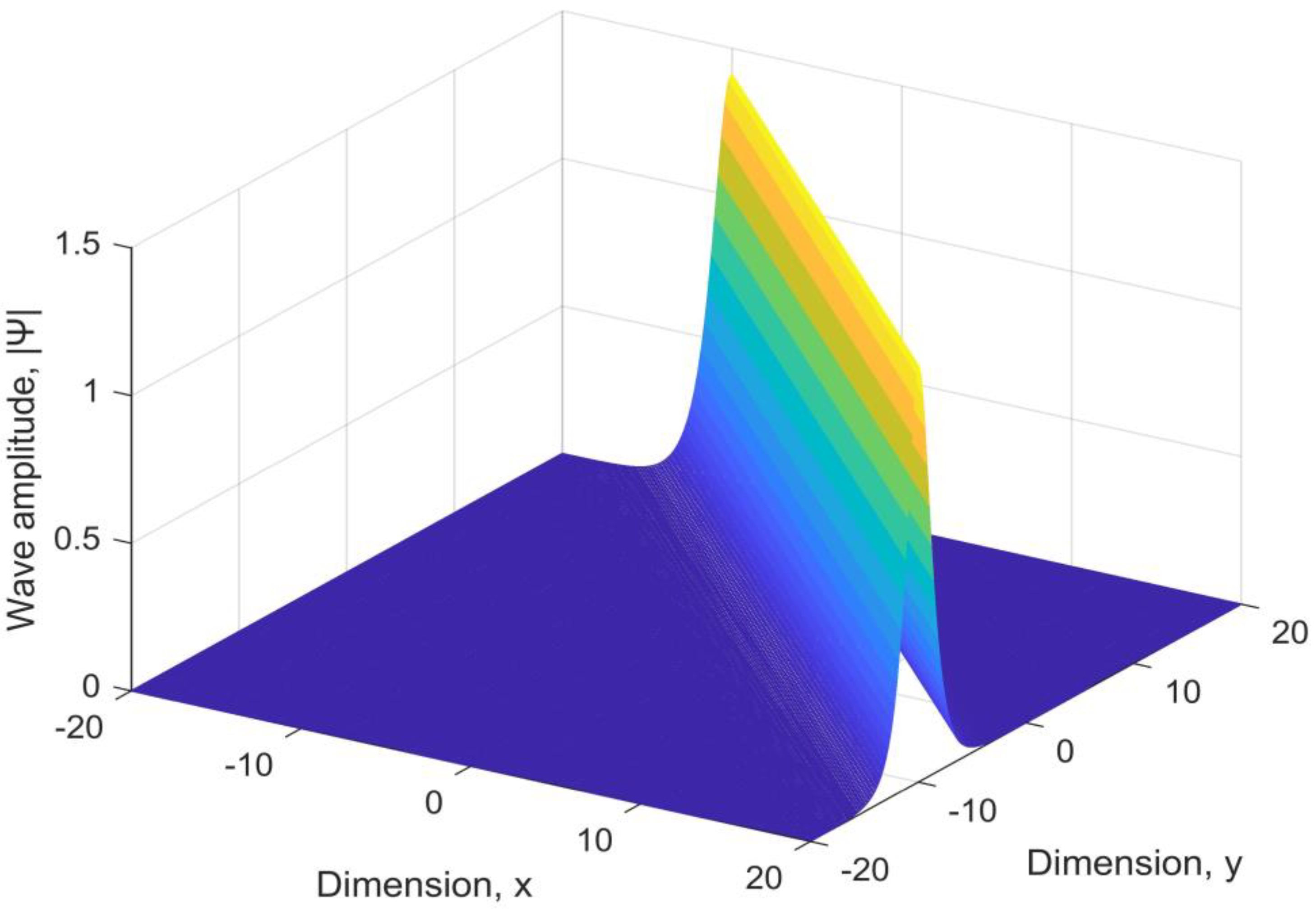
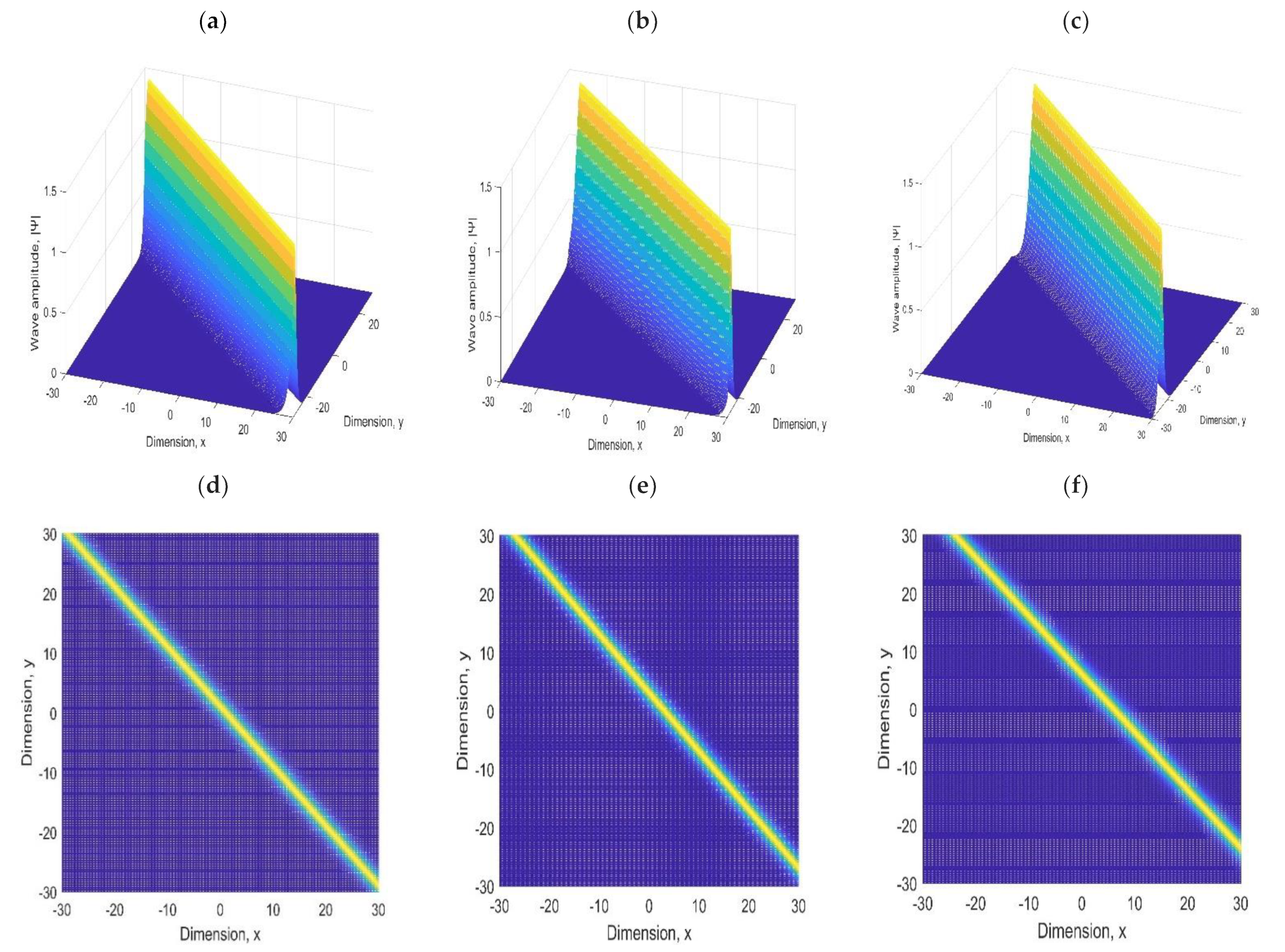

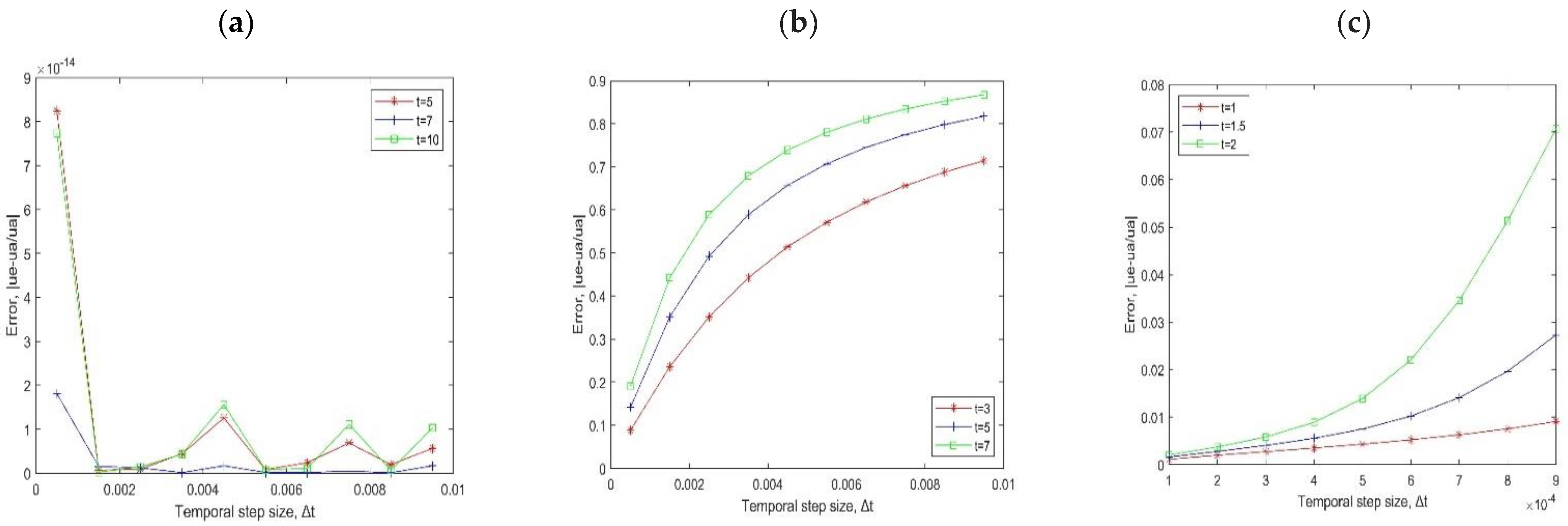

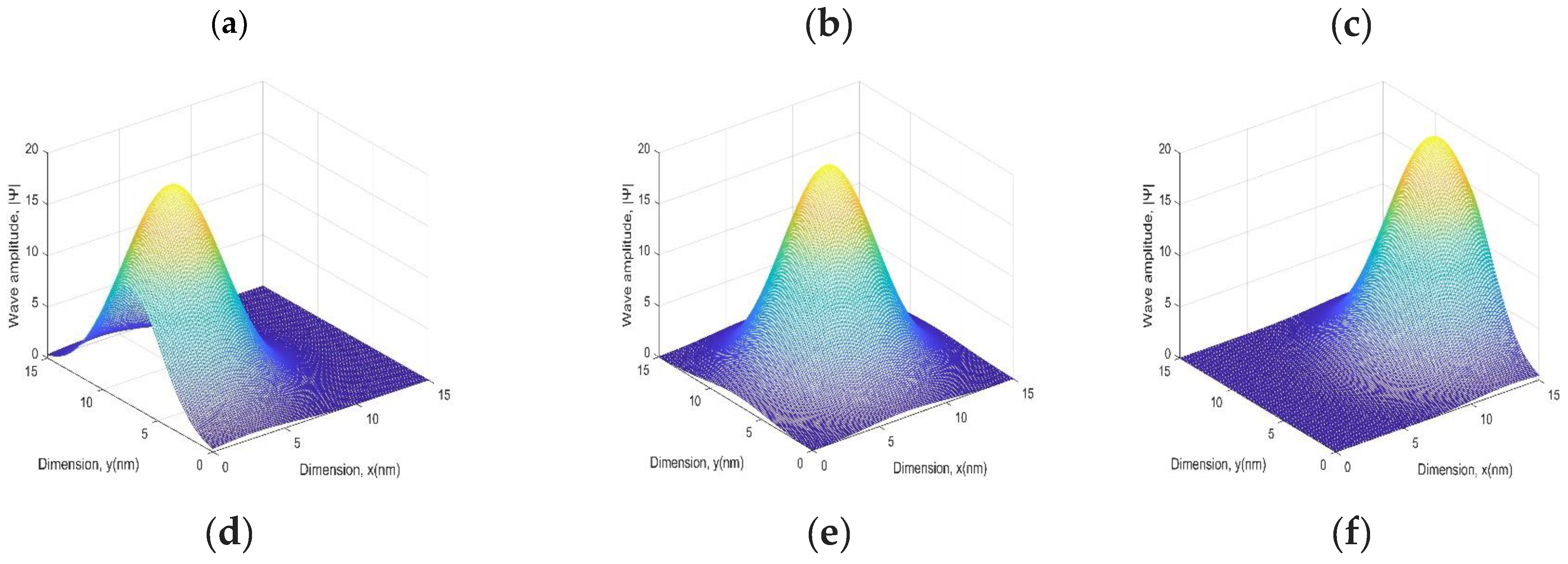
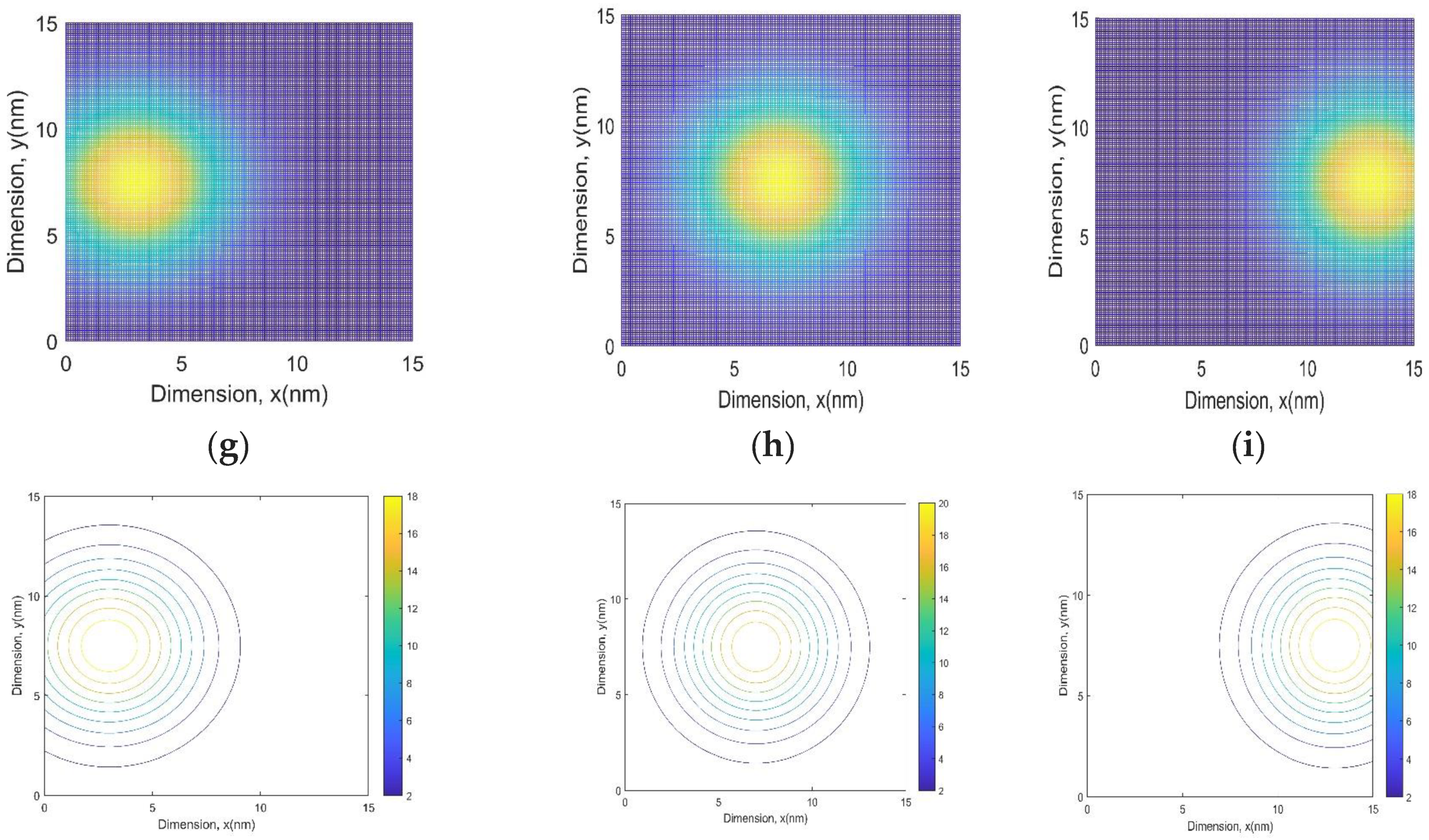

| x | y | -SSFT | -FPSM | -HSM | -EXACT | CPU Time(s)-SSFT | CPU Time(s)-FPSM | CPU Time(s)-HSM |
|---|---|---|---|---|---|---|---|---|
| 1 | 5 | 1.9057 | 2.0523 | 1.9095 | 1.9057 | 2.5108 | 3.6608 | 1.0901 |
| 2 | 7 | 9.4883 | 1.0218 | 9.5074 | 9.4883 | 2.250 | 3.5893 | 1.0856 |
| 3 | 8 | 1.2841 | 1.3829 | 1.2867 | 1.2841 | 2.1515 | 3.9462 | 1.2564 |
| 5 | 10 | 2.3519 | 2.5329 | 2.3567 | 2.3519 | 2.1435 | 4.9033 | 1.0614 |
| 7 | 13 | 1.5847 | 1.7066 | 1.5879 | 1.5847 | 2.1152 | 3.8490 | 1.0929 |
| 9 | 14 | 7.8905 | 8.4968 | 7.9057 | 7.8898 | 2.138 | 3.5086 | 1.0966 |
| 10 | 15 | 1.0680 | 1.1499 | 1.0699 | 1.0678 | 2.1300 | 3.4625 | 1.1075 |
| Time, t | SSFT-SSE | FPSM-SSE | HSM-SSE | CPU Time(s)-SSFT | CPU Time(s)-FPSM | CPU Time(s)-HSM |
|---|---|---|---|---|---|---|
| 0.1 | 1.1245 | 1.3906 | 1.3824 | 3.3838 | 5.2151 | 1.6471 |
| 0.2 | 4.3874 | 5.5797 | 3.5031 | 4.6749 | 7.9404 | 3.2275 |
| 0.4 | 1.6982 | 2.2446 | 8.6132 | 8.7677 | 1.4244 | 5.6874 |
| 0.5 | 2.6874 | 3.5160 | 1.1819 | 1.1225 | 1.7936 | 7.4073 |
| 1 | 1.0716 | 1.4204 | 9.3939 | 2.1427 | 3.4773 | 1.4721 |
| 1.5 | 2.4222 | 3.2157 | 1.3036 | 3.4239 | 5.3946 | 2.1097 |
| 2 | 4.2536 | 5.7390 | 5.7535 | 4.2984 | 7.1198 | 2.7243 |
| x | y | -SSFT | -FPSM | -HSM | -Exact | CPU Time-SSFT (s) | CPU Time-FPSM (s) | CPU Time-HSM (s) |
|---|---|---|---|---|---|---|---|---|
| 1 | 2 | 9.7617 | ||||||
| 3 | 3 | 9.7447 | ||||||
| 4 | 9 | 1.1087 | 1.8664 | 1.1088 | 1.1087 | 9.9013 | ||
| 6 | 10 | 2.6932 | 4.5336 | 2.6972 | 2.6932 | 9.7623 | ||
| 8 | 12 | 1.8053 | 3.0390 | 1.8118 | 1.8053 | 9.7739 | ||
| 9 | 13 | 1.0159 | 1.7100 | 1.0203 | 1.0159 | 9.7287 | ||
| 10 | 15 | 9.7627 |
| Time, t | SSFT-SSE | FPSM-SSE | HSM-SSE | CPU Time(s)-SSFT | CPU Time(s)-FPSM | CPU Time(s)-HSM |
|---|---|---|---|---|---|---|
| 1 | 1.6961 | 3.3541 | 3.4406 | |||
| 3 | 4.9491 | 9.0329 | ||||
| 6 | 9.8193 | |||||
| 8 | ||||||
| 10 | ||||||
| 12 | ||||||
| 15 |
Disclaimer/Publisher’s Note: The statements, opinions and data contained in all publications are solely those of the individual author(s) and contributor(s) and not of MDPI and/or the editor(s). MDPI and/or the editor(s) disclaim responsibility for any injury to people or property resulting from any ideas, methods, instructions or products referred to in the content. |
© 2023 by the authors. Licensee MDPI, Basel, Switzerland. This article is an open access article distributed under the terms and conditions of the Creative Commons Attribution (CC BY) license (https://creativecommons.org/licenses/by/4.0/).
Share and Cite
Farag, N.G.A.; Eltanboly, A.H.; El-Azab, M.S.; Obayya, S.S.A. Numerical Solutions of the (2+1)-Dimensional Nonlinear and Linear Time-Dependent Schrödinger Equations Using Three Efficient Approximate Schemes. Fractal Fract. 2023, 7, 188. https://doi.org/10.3390/fractalfract7020188
Farag NGA, Eltanboly AH, El-Azab MS, Obayya SSA. Numerical Solutions of the (2+1)-Dimensional Nonlinear and Linear Time-Dependent Schrödinger Equations Using Three Efficient Approximate Schemes. Fractal and Fractional. 2023; 7(2):188. https://doi.org/10.3390/fractalfract7020188
Chicago/Turabian StyleFarag, Neveen G. A., Ahmed H. Eltanboly, Magdi S. El-Azab, and Salah S. A. Obayya. 2023. "Numerical Solutions of the (2+1)-Dimensional Nonlinear and Linear Time-Dependent Schrödinger Equations Using Three Efficient Approximate Schemes" Fractal and Fractional 7, no. 2: 188. https://doi.org/10.3390/fractalfract7020188
APA StyleFarag, N. G. A., Eltanboly, A. H., El-Azab, M. S., & Obayya, S. S. A. (2023). Numerical Solutions of the (2+1)-Dimensional Nonlinear and Linear Time-Dependent Schrödinger Equations Using Three Efficient Approximate Schemes. Fractal and Fractional, 7(2), 188. https://doi.org/10.3390/fractalfract7020188







